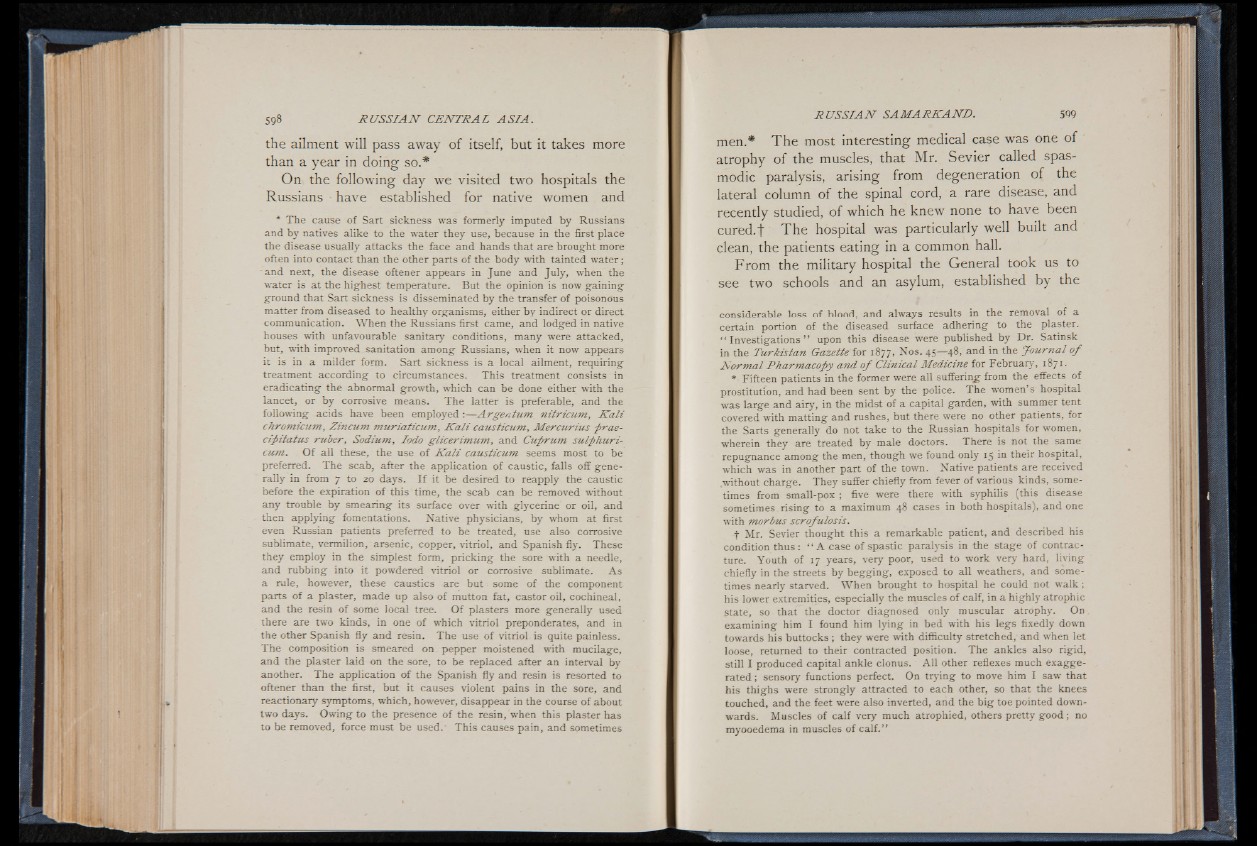
the ailment will pass away of itself, but it takes more
than a year in doing so.*
On the following day we visited two hospitals the
Russians have established for native women and
* The cause of Sart sickness was formerly imputed by Russians
and by natives alike to the water they use, because in the first place
the disease usually attacks the face and hands that are brought more
often into contact than the other parts of the body with tainted water;
and next, the disease oftener appears in June and July, when the
water is at the highest temperature. But the opinion is now gaining
ground that Sart sickness is disseminated by the transfer of poisonous
matter from diseased to healthy organisms, either by indirect or direct
communication. When the Russians first came, and lodged in native
houses with unfavourable sanitary conditions, many were attacked,
but, with improved sanitation among Russians, when it now appears
it is in a milder form. Sart sickness is a local ailment, requiring
treatment according to circumstances. This treatment consists in
eradicating the abnormal growth, which can be done either with the
lancet, or by corrosive means. The latter is preferable, and the
following acids have been employed:— Argentum nitricum, H alt
chromicum, Zincum muriaticum, K a li causticum, Mercurius prae-
cipitatus ruber, Sodium, Iodo glicerimum, and Cuprum sulphuri-
cum. O f all these, the use o f K a li causticum seems most to be
preferred. The scab, after the application of caustic, falls off generally
in from 7 to 20 days. I f it be desired to reapply the caustic
before the expiration o f this time, the scab can be removed without
any trouble by smearing its surface over with glycerine or oil, and
then applying fomentations. Native physicians, by whom at first
even Russian patients preferred to be treated, use also corrosive
sublimate, vermilion, arsenic, copper, vitriol, and Spanish fly. These
they employ in the simplest form, pricking the sore with a needle,
and rubbing into it powdered vitriol or corrosive sublimate. A s
a rule, however, these caustics are but some of the component
parts of a plaster, made up also of mutton fat, castor oil, cochineal,
and the resin of some local tree. O f plasters more generally used
there are two kinds, in one of which vitriol preponderates, and in
the other Spanish fly and resin. The use of vitriol is quite painless.
The composition is smeared on pepper moistened with mucilage,
and the plaster laid on the sore, to be replaced after an interval by
another. The application of the Spanish fly and resin is resorted to
oftener than the first, but it causes violent pains in the sore, and
reactionary symptoms, which, however, disappear in the course of about
two days. Owing to the presence of the resin, when this plaster has
to be removed, force must be used. This causes pain, and sometimes
men.* The most interesting medical case was one of
atrophy of the muscles, that Mr. Sevier called spasmodic
paralysis, arising from degeneration of the
lateral column of the spinal cord, a rare disease, and
recently studied, of which he knew none to have been
cured, t The hospital was particularly well built and
clean, the patients eating in a common hall.
From the military hospital the General took us to
see two schools and an asylum, established by the
considerable loss of blood, and always results in the removal of a
certain portion of the diseased surface adhering to the plaster.
“ Investigations” upon this disease were published by Dr. Satinsk
in the Turkistan Gazette for 1877, Nos. 45— 48, and in the Journal o f
Normal Pharmacopy and o f Clinical Medicine for February, 1871.
* Fifteen patients in the former were all suffering from the effects of
prostitution, and had been sent by the police. The women s hospital
was large and airy, in the midst of a capital garden, with summer tent
covered with matting and rushes, but there were no other patients, for
the Sarts generally do not take to the Russian hospitals for women,
wherein they are treated by male doctors. There is not the same
repugnance among the men, though we found only 15 in their hospital,
which was in another part of the town. Native patients are received
.without charge. They suffer chiefly from fever of various kinds, sometimes
from small-pox ; five were there with syphilis (this disease
sometimes rising to a maximum 48 cases in both hospitals), and one
with morbus scrofulosis.
t Mr. Sevier thought this a remarkable patient, and described his
condition thus: “ A case of spastic paralysis in the stage of contracture.
Youth of 17 years, very poor, used to work very hard, living
chiefly in the streets by begging, exposed to all weathers, and sometimes
nearly starved. When brought to hospital he could not w a lk ;
his lower extremities, especially the muscles of calf, in a highly atrophic
state, so that the doctor diagnosed only muscular atrophy. On
examining him I found him lying in bed with his legs fixedly down
towards his buttocks; they were with difficulty stretched, and when let
loose, returned to their contracted position. The ankles also rigid,
still I produced capital ankle clonus. A ll other reflexes much exa gg e rated
; sensory functions perfect. On trying to move him I saw that
his thighs were strongly attracted to each other, so that the knees
touched, and the feet were also inverted, and the b ig toe pointed downwards.
Muscles of calf very much atrophied, others pretty g o o d ; no
myooedema in muscles of ca lf.”